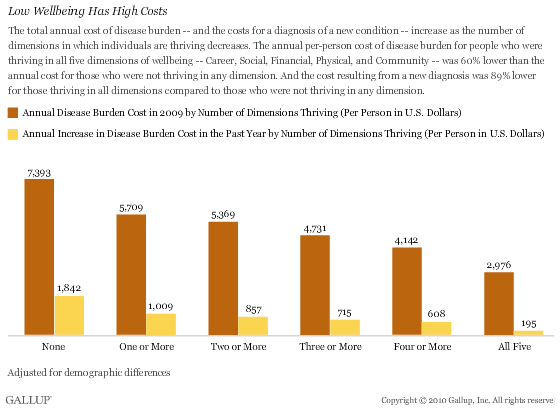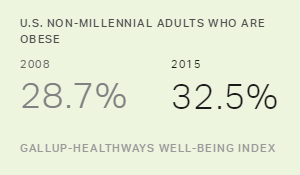There just might be something to the saying "I feel like a million bucks."
OK, the monetary amount is probably an exaggeration, but Gallup researchers Jim Harter, Ph.D., and Sangeeta Agrawal have determined the price people pay for poor well-being, both financially and physically. Those costs extrapolate to the larger discussion of healthcare reform in the United States. And taking the right actions to increase well-being can have a significant impact on improving healthcare and lessening the burden of poor well-being on employees, their employers, and the country as a whole.
Wreaking havoc, physically and financially
Harter, chief scientist for Gallup's workplace management and well-being practices, and Agrawal, a senior researcher, conducted a series of surveys of U.S. households. They measured overall well-being and monitored change in disease burden for specific chronic conditions such as high blood pressure, high cholesterol, depression, heart disease, diabetes, sleep disorder/insomnia, and anxiety.

The study defines increase in disease burden as one or more new incidences of the previously mentioned conditions. Increases in disease burden were identified using three independent surveys that measured whether respondents were diagnosed with one or more new conditions in 2009 compared to 2008 or had no new diseases diagnosed in 2009.
Gallup categorizes individuals' overall well-being as "thriving" (strong, consistent, and progressing), "struggling" (moderate or inconsistent), or "suffering" (at high risk). One-third of struggling or suffering adults (35%) reported an increase in their disease burden. Comparatively, one in five thriving adults (21%) reported an increase in disease burden. This means that adults with struggling or suffering well-being were 64% more likely than adults with thriving well-being to have one or more new disease conditions diagnosed in the past year.
Along with the physical cost, that 64% figure is significant because of the financial costs associated with these conditions. Gallup's researchers reported a distinct difference in the cost of disease burden when comparing these two groups of adults. Thriving adults averaged an annual disease burden cost of $4,929 per person compared to $6,763 per person averaged by struggling and suffering adults. This represents a 37% cost difference, with struggling and suffering adults averaging $1,834 more in disease burden costs per person than their thriving counterparts.
Those assessments include all diseases, not just new incidences from the previous year. Still, the news is grim for those who are struggling or suffering. From 2008 to 2009, the average annual cost of new disease burden for adults who were struggling or suffering was $1,488 per person; this was about twice as much as the $723 in average annual costs of new disease burden incurred by thriving adults.
Gallup researchers also measure well-being in five dimensions of an individual's life: Career, Social, Financial, Physical, and Community. Harter and Agrawal found that the likelihood of disease burden increase is lowest for adults with thriving levels of well-being in all five dimensions. And as the number of dimensions in which an adult is thriving decreases, the likelihood of disease burden escalates. Individuals who were not thriving in any of the five dimensions of well-being, for example, had a 35% likelihood of incurring increased disease burden in the previous year compared to 11% for those with thriving well-being in all five dimensions.

Not surprisingly, the total annual disease burden costs and new disease burden costs increase as the number of well-being dimensions in which individuals are thriving decreases. In 2009, the annual cost of disease burden for individuals who were not thriving in any dimension of well-being was $7,393 per person. In sharp contrast, the cost was $2,976 per person for people who were thriving in all five dimensions -- a 60% difference. Similarly, the per-person cost of change in disease burden resulting from a new diagnosis was $1,842 for people who were not thriving in any well-being dimension but just $195 for those who were thriving in all five dimensions (a difference of 89%).

Chronic economic impact
The macroeconomic costs of poor well-being are astonishing, yet unfortunately consistent. A 2007 Milken Institute report titled An Unhealthy America: The Economic Burden of Chronic Disease estimates that seven of the most common chronic diseases cost the economy more than $1 trillion each year. The Centers for Disease Control (CDC) and Prevention finds that chronic diseases such as asthma, heart disease, cancer, and diabetes kill more than 1.7 million Americans each year and are responsible for more than 70% of the deaths in the United States. The CDC observes that to a large degree, chronic illnesses like the ones included in Gallup's research are preventable and the result of the daily choices people make, and about 133 million Americans live with at least one chronic condition. Further, one in four of these adults experience significant limitations to their daily activities. All told, the financial implications of chronic illnesses are enormous, with a majority of the money spent on healthcare due directly to these types of diseases.
What does this mean for the nation's employers? Gallup's research shows that adults with thriving well-being are less likely to suffer an increase in disease burden and the related financial consequences. The outcomes of higher well-being can translate to savings in healthcare costs for individuals and employers; they can also reduce absenteeism among employees and limit what the Milken study refers to as "presenteeism," or showing up for work to avoid losing wages but working below par. The Milken study finds the long-term impact of chronic diseases on economic growth more substantial than treatment costs and lost labor outputs.
How organizations can remedy problems
It would make sense, then, for employers in all industries and sectors to focus on helping workers improve their well-being. Physical Well-Being is obviously a large part of the equation: Milken's 2007 study found that lowering obesity rates could reduce illness, significantly lower the national healthcare treatment bill, and improve GDP. What's at stake? Hundreds of billions of dollars of improvements in productivity and total economic impact, not to mention reduced mortality rates. But Gallup's well-being science emphasizes the importance of the other four dimensions: Career, Social, Financial, and Community Well-Being.
Employers are well-positioned to help people improve their short-term and long-term well-being in all dimensions.
"A high percentage of healthcare costs are due to things we can all directly affect -- our diet, exercise, weight, and other habits," says Harter, who coauthored the book Wellbeing: The Five Essential Elements. But many other aspects of our lives can influence our long-term physical health, including our careers, social lives, finances, and communities.
"Most people have the right long-term goals of good health; engaging careers; positive relationships; financial security; and having a safe, engaging place to live," says Harter. "The problem is that people don't always align short-term incentives with these longer term goals -- that is, to do things that make them feel better today and give them a better life in the long term."
Harter says that employers are well-positioned to help people improve their short-term and long-term well-being in all dimensions. "Probably the most efficient place to create change in this area is through organizations. They have natural social networks, cultural expectations, and an infrastructure to provide well-being resources. Through ongoing measurement, education, and positive defaults, employers can take the lead in creating awareness and long-term change," Harter says.
But what specifically can employers do to improve their workforce's well-being? Harter believes it starts with building an engaging work environment. This includes fortifying an organization with great managers and offering employees support and structure to achieve thriving levels of well-being in all dimensions. "While organizations probably shouldn't approach well-being from a paternalistic perspective," says Harter, "they can offer opportunities that improve the odds that their employees will do what is best for themselves and make clear that thriving well-being is an expectation within the organization."
Because employees and employers pay the financial consequences of poor well-being -- and healthy employees often foot the bill for their unhealthy colleagues -- it makes sense to invest time and money in providing resources to help employees improve all dimensions of their well-being. Harter says organizations can do things to enhance their employees' social lives by giving them opportunities at work to build relationships and the flexibility to take care of family matters when necessary. He believes that organizations can offer employees options to learn financial management skills through relevant programs and education classes. And he thinks organizations can take an active role in connecting employees to community involvement opportunities that fit their strengths and interests.
"Over time, the brand of an organization can be that employees expect their lives to be better in five years as a result of working for that organization," Harter says. "Organizations have already accomplished this with employee engagement, and the next logical extension is employee well-being."
"It's important that organizations work on prevention and early intervention by understanding that the well-being elements are interdependent," Harter says. "Prevention doesn't just involve motivating people to take part in exercise programs and make healthy food choices. It involves thinking about how these good habits interact with all the other well-being elements. As with engagement, the most progressive organizations will realize that their job is to improve people's lives as they improve their performance."
These survey findings come from a database featuring a longitudinal sample of 662 adults compiled by combining three independent surveys from the Gallup Panel of U.S. households. Two of the surveys took place in 2008, and the third took place in 2009. The research controlled for age, marital status, income level, gender, and education level. Estimates of disease burden cost for each disease were adjusted to 2009 healthcare, absence, and short-term disability costs and calculated to find the total cost of disease burden and the total cost of disease burden change.
